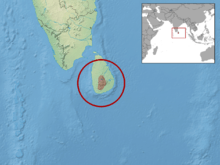Lankascincus taprobanensis
Lankascincus taprobanensis, also known as the Ceylon tree skink, is a species of skink endemic to the island of Sri Lanka.[1][3]
| Smooth Lanka skink | |
|---|---|
| Scientific classification | |
| Kingdom: | Animalia |
| Phylum: | Chordata |
| Class: | Reptilia |
| Order: | Squamata |
| Family: | Scincidae |
| Genus: | Lankascincus |
| Species: | L. taprobanensis |
| Binomial name | |
| Lankascincus taprobanensis | |
 | |
Habitat and distribution
The smooth Lanka skink is found from 1,000 to 2,300 metres (3,300 to 7,500 ft) above sea level, and is the only skink found at the 2,300-metre (7,500 ft) elevation in Sri Lanka. It is common in the Horton Plains, Hakgala, Namunukula, and Nuwara Eliya.[4]
Description
The body is stout, and the tail is 1.3 to 1.5 times that of the body. The fronto-parietals are distinct. The parietals are in narrow contact. There are 24 to 27 rows of scales in the midbody. There are 9 to 17 lamellae under the fourth toe. The dorsum is gray, reddish brown, brownish yellow, or olive colored. Each scale has a median dark spot. There is a brownish black lateral stripe with yellowish cream flecks running from the eye to the base of the tail. The venter is lemon yellow. The throat is pale blue with a few scattered dark spots. Irises are very dark brown colored.
Ecology and diet
Its diet includes insects.[1]
Reproduction
It lays 1 to 2 eggs, each measuring 7 by 12.5 millimetres (0.28 by 0.49 in), per clutch in loose soil. Hatchlings measure 19 millimetres (0.75 in).
References
- de Silva, A. & Somaweera, R. (2010). "Lankascincus taprobanensis". IUCN Red List of Threatened Species. 2010: e.T178728A7604317. doi:10.2305/IUCN.UK.2010-4.RLTS.T178728A7604317.en.
- "Lankascincus taprobanensis Kelaart, 1854". Global Biodiversity Information Facility. November 3, 2014. Retrieved April 3, 2015.
- "Lankascincus taprobanensis". The Reptile Database. Retrieved April 3, 2015.
- "Endemic Scincid Lizards of Sri Lanka". Endemic Animals of Sri Lanka. 2011. Retrieved April 3, 2015.
